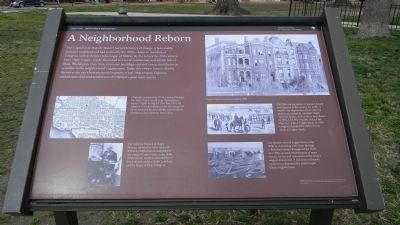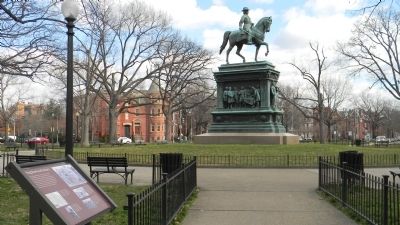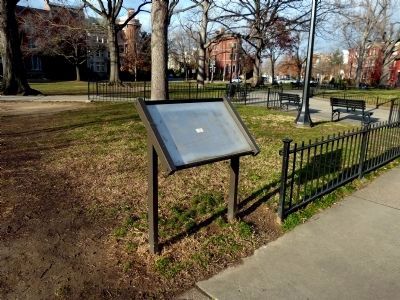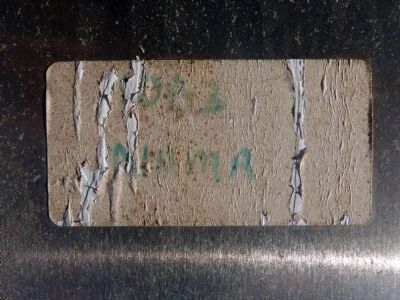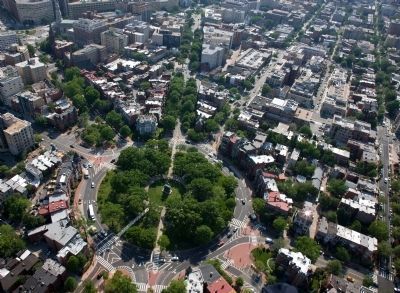Logan Circle in Northwest Washington in Washington, District of Columbia — The American Northeast (Mid-Atlantic)
A Neighborhood Reborn
Logan Circle, National Mall & Memorial Parks
— National Park Service, U.S. Department of the Interior —
The Logan Circle Historic District has a rich history of change. A fashionable, exclusive neighborhood had evolved by the 1870s – home to members of Congress, such as Senator John Logan of Illinois. By the turn of the 20th century, Iowa – later Logan – Circle flourished as a social intellectual, and artistic hub of Black Washington. Over time, economic hardships and civil unrest contributed to a decline in the neighborhood’s appearance. Today, this vibrant historic district thrives as the city’s best-preserved example of late 19th-century Victorian architecture clustered around one of L’Enfant’s great open spaces.
[Captions:]
Originally purchased in 1791 by Samuel Blodgett, this land served as an “executioner’s square” (right) during the Civil War. The 1864 addition of a horse-drawn trolley line along 14th Street increased the accessibility and desirability of what became known as Iowa Circle.
The National Council of Negro Women, founded by Mary McLeod Bethune, established its headquarters just south of Logan Circle in the 1940s. Other famous residents included boxer Jack Johnson, architect John Lankford, and the family of Duke Ellington.
Civil War-era population expansion forced development of this area by the 1870s. A massive city improvement plan induced prominent citizens to construct stately Victorian homes, such as those seen above. In 1901, Civil War veterans erected the Maj. Gen. John A. Logan statue. In 1930 Congress changed the name of Iowa Circle to Logan Circle.
City planners altered Logan Circle in the 1950s by channeling 13th Street through it. Renewed interest throughout the 1970s and 1980s spurred refurbishment of many historic houses and restoration of the circle’s original dimensions. A rich sense of history continues to dominate the entire Logan Circle neighborhood.
Erected 2011 by National Park Service, U.S. Department of the Interior.
Topics and series. This historical marker is listed in these topic lists: African Americans • Architecture • Civil Rights • Roads & Vehicles • Settlements & Settlers • War, US Civil. In addition, it is included in the Mary McLeod Bethune series list. A significant historical year for this entry is 1791.
Location. This marker has been replaced by another marker nearby. It was located near 38° 54.573′ N, 77° 1.797′ W. Marker was in Northwest Washington in Washington, District of Columbia. It was in Logan Circle. Marker could be reached from the intersection of Logan Circle Northwest and Rhode Island Avenue Northwest, on the right when traveling south. Marker was off the walkway in the western section of Logan Circle Park which is inside the Logan Circle Northwest traffic loop. It was accessible to pedestrians from either the eastern or western extensions of P Street Northwest and Rhode Island Avenue Northwest - or the northern or southern extensions of 13th Street Northwest and Vermont Avenue Northwest. Touch for map. Marker was in this post office area: Washington DC 20005, United States of America. Touch for directions.
Other nearby markers. At least 8 other markers are within walking distance of this location. Logan Circle (here, next to this marker); Major General John A. Logan (within shouting distance of this marker); The Artistic Life (within shouting distance of this marker); 6 Logan (within shouting distance of this marker); John Logan House (within shouting distance of this marker); a different marker also named Logan Circle (within shouting distance of this marker); a different marker also named John Logan House (within shouting distance of this marker); Belford V. Lawson and Marjorie M. Lawson Residence (within shouting distance of this marker). Touch for a list and map of all markers in Northwest Washington.
Also see . . . Logan Circle. Logan Circle is a traffic circle, neighborhood, and historic district in the Northwest quadrant of Washington, D.C. The primarily residential neighborhood includes two historic districts, properties listed on the National Register of Historic Places, and sites designated D.C. Historic Landmarks. It is the only major circle downtown that remains entirely residential. ... (Submitted on February 27, 2012, by Richard E. Miller of Oxon Hill, Maryland.)
Additional keywords. Logan Circle Historic District
Credits. This page was last revised on January 30, 2023. It was originally submitted on February 26, 2012, by Richard E. Miller of Oxon Hill, Maryland. This page has been viewed 725 times since then and 8 times this year. Last updated on February 18, 2013, by Allen C. Browne of Silver Spring, Maryland. Photos: 1, 2. submitted on February 26, 2012, by Richard E. Miller of Oxon Hill, Maryland. 3, 4. submitted on February 18, 2013, by Allen C. Browne of Silver Spring, Maryland. 5. submitted on February 27, 2012, by Richard E. Miller of Oxon Hill, Maryland. • Craig Swain was the editor who published this page.
